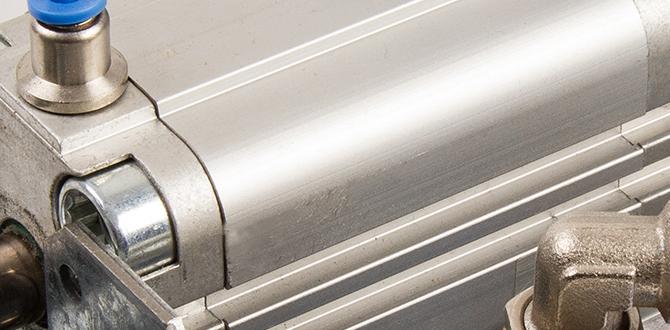Quick Summary: Using a pneumatic nailer for outdoor decking is efficient and effective. This guide explains essential steps: choosing the right nailer and nails, preparing your deck, safe operation, and proper fastening techniques for a strong, beautiful deck.
Building an outdoor deck is a rewarding DIY project. It adds beauty and functionality to your home. One of the biggest challenges, especially for beginners, can be fastening the deck boards securely and evenly. This is where a pneumatic nailer truly shines. If you’re wondering how to use a pneumatic nailer for outdoor decking, you’ve come to the right place! We’ll break down everything you need to know, making this task simpler and more approachable than you might think. Get ready to tackle your decking project with confidence and efficiency.
Table of Contents
Why Use a Pneumatic Nailer for Decking?
When it comes to building an outdoor deck, speed and precision are key. A pneumatic nailer, powered by compressed air, delivers nails quickly and consistently, significantly speeding up the process compared to manual hammering. This is especially beneficial when you’re laying dozens, or even hundreds, of deck boards. Beyond speed, pneumatic nailers set nails flush or slightly countersunk, providing a clean finish and preventing future snags. For repetitive tasks like decking, they reduce user fatigue, allowing you to work more comfortably for longer.
Think about the alternative: hammering each nail individually. It’s time-consuming, physically demanding, and it’s easy to miss the mark, leading to bent nails, damaged wood, or an uneven appearance. A good pneumatic nailer, used correctly, ensures each nail goes in straight and true, contributing to a much stronger and more professional-looking final deck.
Choosing the Right Pneumatic Nailer for Decking
Not all pneumatic nailers are created equal, and using the wrong one for your decking project can lead to frustration. For outdoor decking, you primarily need a nailer that can handle the length and gauge of nails required for securely fastening deck boards to joists.
Types of Pneumatic Nailers: What Works for Decks?
While there are many types of nailers, two are most relevant for deck construction:
- Framing Nailers: These are heavy-duty nailers designed for structural work. They drive larger, longer nails (typically 2 to 3.5 inches or more) that are perfect for securing joists, beams, and the main structure of your deck. For attaching your deck boards, a framing nailer with adjustable depth control can work, but it’s often overkill and might drive nails too deep if not calibrated carefully.
- Finish Nailers: These are designed for more delicate work, driving slimmer nails with minimal damage to the wood surface. They are generally too light and drive nails that are too short for securely fastening deck boards.
- Specific Decking Nailers: Some manufacturers offer specialized decking nailers. These are often a type of framing nailer optimized for decking applications, sometimes featuring specific nail collations or features for ease of use on deck boards. If you find one of these, it’s likely a great choice.
For most DIYers tackling deck boards, a good quality framing nailer with adjustable depth control is your best bet. You’ll be driving nails from 2.5 to 3 inches long into your deck boards and joists.
Key Features to Look For:
- Adjustable Depth Control: This is crucial. It allows you to set how deep the nail penetrates the wood. For decking, you want nails to be flush or slightly below the surface. This prevents them from catching on shoes or becoming a tripping hazard.
- Nail Firing Mode (Sequential vs. Bump Fire): Most framing nailers offer both. Sequential firing drives one nail per trigger pull, which is safer for precise placement. Bump fire (also called contact actuation) drives a nail every time the nose touches the wood and the trigger is held down, allowing for speed. For decking, you might find bump fire useful for quickly tacking boards in place before final fastening, but sequential fire is generally recommended for consistent, secure drives.
- Magazine Capacity: A higher capacity means you won’t have to reload as often, saving you time.
- Ergonomics: You’ll be holding the nailer for extended periods. A comfortable grip and balanced weight distribution will make a big difference.
- Power/PSI: Ensure the nailer is powerful enough for the length of nails you’ll be using and can operate at the PSI recommended by the manufacturer.
Essential Supplies for Pneumatic Decking
Beyond the nailer itself, you’ll need a few other critical items to get the job done safely and effectively. This is where planning really pays off!
Tools and Materials Checklist:
- Pneumatic Nailer: As discussed, a framing nailer is ideal.
- Air Compressor: This powers your nailer. Ensure it has a sufficient CFM (Cubic Feet per Minute) rating to keep up with your nailer’s demand. Check your nailer’s manual for recommendations. A 2-gallon to 6-gallon portable compressor is often suitable for typical deck projects.
- Air Hose: A good quality air hose of appropriate length (don’t skimp here – you need to reach everywhere!) is essential. A 3/8-inch diameter hose is common and works well.
- Nails: This is vital! For outdoor decking, you need exterior-grade nails that resist rust and corrosion. Common choices are galvanized or stainless steel nails. The length and gauge depend on your deck board thickness and joist material. For 5/4″ or 2×6 deck boards, nails around 2.5 to 3 inches long are typical. Always check your deck plans or local building codes for specific requirements. A common gauge for framing nails is .120 to .131.
- Safety Glasses: Absolutely non-negotiable. Always wear impact-resistant safety glasses to protect your eyes from flying debris or accidental nail ricochets.
- Hearing Protection: Nail guns can be loud. Earplugs or earmuffs are recommended for prolonged use.
- Gloves: Work gloves will protect your hands from splinters and provide a better grip.
- Measuring Tape: For accurate spacing and placement.
- Pencil: For marking.
- Chalk Line or String Line: For guiding straight runs of boards.
- Level: To ensure your boards are straight.
- Clamps: Can be helpful for holding boards in place while you nail them.
- Air Fittings: You’ll need the correct fittings to connect the air hose to both the compressor and the nailer.
- Lubricant (optional but recommended): A few drops of air tool oil in the compressor’s air line can help keep your nailer running smoothly.
It’s also a good idea to familiarize yourself with your specific nailer’s manual. Every tool is a little different, and knowing its quirks will save you headaches.
Step-by-Step: How to Use Your Pneumatic Nailer for Decking
Now that you have your tools and materials ready, let’s get to the practical steps of using your pneumatic nailer to install your outdoor deck boards. Safety first, always!
Step 1: Connect Air Supply and Test Nailer
Before you start firing nails into your deck, it’s essential to set up your air supply and test the nailer. This ensures everything is working correctly and you’re familiar with its operation.
- Connect the Air Hose: Attach one end of the air hose to the air compressor’s outlet fitting and the other end to your pneumatic nailer’s air inlet. Ensure both connections are secure.
- Check the Compressor: Turn on your air compressor and set the pressure. Consult your nailer’s manual for the recommended operating pressure (PSI – Pounds per Square Inch). For most framing nailers used in decking, this range is typically between 70-120 PSI. Do not exceed the nailer’s maximum rated pressure.
- Load Nails: Open the magazine of your nailer and load the appropriate exterior-grade nails for decking. Make sure they are seated correctly and that the magazine is securely closed.
- Test Fire (Safely!): Find a scrap piece of lumber similar to your deck boards and joists. Point the nailer at the scrap wood and pull the trigger. The nail should drive into the wood.
- Adjust Depth Control: If the nail is driven too deep (below the surface), turn the depth adjustment dial counter-clockwise (or as per your manual) to set it shallower. If it’s too proud (sticking out), turn it clockwise to set it deeper. Your goal is to have the nail head just slightly below the surface for a clean, snag-free finish. Test fire again on the scrap wood until you achieve the desired results.
Important Safety Note: Never point the nailer at yourself or anyone else, even without air pressure connected. Keep your trigger finger off the trigger until you are ready to fire a nail.
Step 2: Prepare Your Deck Frame
A solid and well-prepared frame is the foundation of a great deck. Ensure your joists are properly spaced and are at the correct height.
- Joist Spacing: Most deck boards are designed for joists spaced either 16 inches on center (OC) or 12 inches OC for heavier loads or specific board types. Ensure your frame meets these requirements. Consult your deck plans or local building codes. For guidance on joist spacing, check resources like FEMA’s Homeowner’s Guide to Building Resilient Homes (Pages 34-36 discuss structural elements like joists).
- Framing Condition: Ensure all framing lumber is in good condition, free from rot or damage.
- Clear Debris: Remove any sawdust, wood scraps, or debris from the top of the joists where your deck boards will sit. This ensures a flush fit.
Step 3: Lay Out Your First Deck Board
The first board often sets the tone for the rest of your deck. Precision here is important.
- Starting Point: Typically, you’ll start at one edge of your deck, usually against your house or a railing.
- Alignment: Position your first deck board. Ensure it is straight and flush with the edge of your deck frame. For a professional look, some builders will have a slight overhang on all outer perimeter boards. Verify this with your design or preference.
- Spacing: Plan for a small gap between deck boards to allow for expansion and drainage. A common gap is 1/8 inch to 1/4 inch. You can use a nail, a spacer tool, or even a specialized decking spacer to maintain consistent gaps.
Step 4: Nailing the Deck Boards
This is where your pneumatic nailer comes into play. We recommend driving two nails per joist for secure fastening.
- Position the Nailer: Place the nose of the nailer firmly against the deck board, directly over a joist.
- Fire the First Nail: Ensure you are using sequential firing mode for precision. Pull the trigger to drive the first nail. Listen to the sound and feel the recoil. If you’ve set your depth correctly, the nail should go in perfectly.
- Fire the Second Nail: Position the nailer slightly further down the board to drive a second nail into the same joist. Aim for a spacing of about 1 to 1.5 inches from the first nail and about 0.5 to 1 inch from the edge of the board. This prevents splitting the wood.
- Spacing Between Joists: Repeat the process for every joist the board crosses.
- Maintain Board Alignment: As you move down the board, use your chalk line, string or visual cues to ensure the board remains straight. You can also use clamps to hold boards in place before nailing.
- Consistent Gaps: Use your chosen spacer method to maintain consistent gaps between boards.
Tip for End Joints: When two deck boards meet end-to-end on a joist, they should ideally land on the center of the same joist. You’ll drive two nails into the joist for each board. Staggering these end joints across different joists adds structural integrity to your deck.
Step 5: Managing Air Pressure and Nailer Performance
Maintaining consistent air pressure is key to a pneumatic nailer’s performance. Fluctuations can lead to nails not driving properly.
- Monitor the Compressor: Keep an eye on your air compressor’s tank pressure. It should stay within the recommended operating range for your nailer.
- Compressor Cycling: Allow your compressor to cycle on and off to maintain pressure. Some larger projects might require a compressor with a larger tank to keep up with demand.
- Hose Length and Diameter: A very long or narrow air hose can cause a drop in air pressure, affecting nail depth and power. Ensure your hose is of suitable quality and length for your project.
- Lubrication: Regularly lubricating your nailer (if recommended by the manufacturer) with air tool oil will ensure smooth operation and prevent internal damage. Add a few drops to the air inlet before each use.
You can learn more about common pneumatic tool issues and maintenance on resources like OSHA’s Tool Safety Pocket Guide, which touches upon safe operation and maintenance of power tools.
Table: Recommended Nail Specifications for Decking
Choosing the right nail is as important as choosing the right nailer. Here’s a general guide, but always consult your deck board manufacturer’s recommendations and local building codes.
| Deck Board Thickness | Typical Nail Length | Typical Nail Gauge (Diameter) | Nail Material Recommendation |
|---|---|---|---|
| 5/4″ (approx. 1″) | 2.5″ – 3″ | .120″ – .131″ | Hot-dip galvanized (minimum G185 coating) or stainless steel |
| 2″ (actual 1.5″) | 2.5″ – 3″ | .120″ – .131″ | Hot-dip galvanized (minimum G185 coating) or stainless steel |
| 2×6 (actual 1.5″ x 5.5″) | 2.5″ – 3″ | .120″ – .131″ | Hot-dip galvanized (minimum G185 coating) or stainless steel |
Note: The gauge refers to the diameter of the nail wire. A larger gauge number means a thinner nail. For decking, a thicker nail (smaller gauge number) is generally preferred for greater holding power. Always ensure your nails are specifically rated for exterior use to prevent rust and staining.
Safety First: Operating Your Nailer Responsibly
Working with pneumatic tools requires respect for their power. Safety should be your top priority at all times.
Crucial Safety Precautions:
- Always Wear Safety Glasses: This cannot be stressed enough. Protect your eyes from flying debris, wood chips, and ricocheting nails.
- Wear Hearing Protection: Prolonged exposure to the noise from a nailer can cause hearing damage.
- Keep Hands and Body Clear: Never point the nailer at yourself or others. Keep your hands and any other body parts away from the firing mechanism and the path of the nail.
- Use the Sequential Trigger: For accuracy and safety, especially when starting out, use the sequential firing mode. This requires you to intentionally pull the trigger for each nail.
- Never Disconnect the Air Hose While Pressurized: Always disconnect the air supply from the nailer before performing any maintenance, clearing jams, or storing the tool.
- Check for Damage: Before each use, inspect the nailer for any damaged parts, such as a cracked housing or bent magazine. Do not use a damaged tool.
- Store Safely: When not in use, disconnect the air supply and store the nailer in a secure place.
- Be Aware of Your Surroundings: Ensure no one is behind your work area where a nail could exit the wood.
- Understand Recoil: Pneumatic nailers have recoil. Be prepared for it and maintain a stable stance.
- Clear Jams Safely: If a nail jams, disconnect the air supply, remove the power source (if battery-powered), and carefully clear the jam using the tool’s provided mechanisms or appropriate tools. Never




